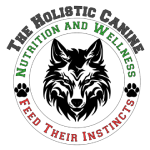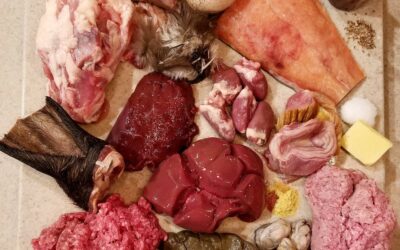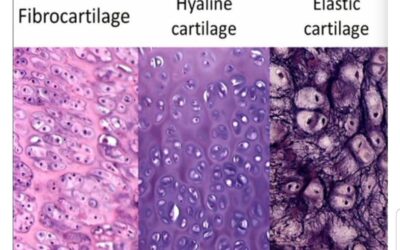Balanced Meal EXAMPLE
Creating a balanced raw meal can be very daunting, especially for the pet parent new to DIY raw feeding. I have created an example meal plan guideline to assist raw feeders on their journey to creating nutrient-balanced meals. I chose easy-to-source grocery store ingredients to make it even more user-friendly for those just starting out in the world of DIY raw pet foods.
To get started you will need:
- your dog’s daily nutrient requirements
- food scale
- food nutrient profile database (I use this one)
- calculator (unless you are a math wiz)
- spreadsheet for auditing nutrients (join our community to get one free)
- ingredients!
According to the NRC’s minimum nutrient requirements, a 45 pound dog must have the following nutrient minimums per day.
- Protein: 31.5 g
- Fat: 17.3 g
- Linoleic acid (omega-6): 3.3 g
- Alpha-linolenic acid (omega-3): 0.13 g
- EPA & DHA (omega-3): 0.3 g
- Calcium: 1.3 g (1,300 mg)
- Phosphorus: 1 g (1,000 mg)
- Iron: 9.6 mg
- Magnesium: 189 mg
- Potassium: 1.34 g (1,340 mg)
- Sodium: 251.5 mg
- Zinc: 19.2 mg
- Copper: 2 mg
- Manganese: 1.5 mg
- Selenium: 113.3 mcg
- Chloride: 384 mg
- Iodine: 284.1 mcg
- Vitamin A: 480 RE
- Vitamin D: 4.3 mcg
- Vitamin E: 9.6 mg*
- Vitamin K: 0.52 mg
- Thiamine (B1): 0.7 mg
- Riboflavin (B2): 1.6 mg
- Niacin (B3): 5.5 mg
- Pantothenic acid (B5): 4.7 mg
- Pyridoxine (B6): 0.47 mg
- Folate: 85.4 mcg **
- Cobalamin (B12): 11 mcg
- Choline: 357.5 mg
*this is the alpha only, unfortunately. Vitamin E must be supplied as the complex of tocopherols.
**this is the folic acid (poorly absorbed synthetic version of folate) calculation, unfortunately
For a 45 pound dog that requires approximately 3% (of body weight) per day, I am going to calculate 2.5% to save room for my extras. 2.5% of 45 pounds =
1.125 pounds (18 ounces) of meat, organs, and bone (per DAY)
For beginner raw feeders, follow the 80/10/10 guideline. This is the easiest ratio to follow. If I were to follow the 80/10/10 guideline exactly, this is how it would look:
An 80/10/10 ratio for 18 ounces would be as follows:
80%: 14.4 ounces
10%: 1.8 ounces
10%: 1.8 ounces
Breaking this down further:
80% meat should be fed approximately 65% muscle + 15% organ muscle:
65%: 11.7 ounces
15%: 2.7 ounces
10% organs should be fed 5% liver + 5% other secreting organ:
5%: 0.9 ounces
5%: 0.9 ounces
10% bone remains the same
As a guideline you will feed approximately:
11.7 oz. muscle meat
2.7 oz. organ muscle
1.8 oz. bone
0.9 oz. liver
0.9 oz. other secreting organ
Total 18 oz.
Now let’s create a meal! I will notate the more hard-to-source nutrients as well as those that are richest in each food ingredient. Vitamins A, D, K, and the B complex vitamins are fairly easy to source; therefore, I will not be concerned with those unless noted due to their nutrient-saturation in the ingredient. Be sure to check what nutrients are in each food you are adding by referring to the nutrient-database you have chosen to use. You need to adjust the ingredients and amounts in order to meet nutrient requirements. Use highest nutrient per bite ratio foods!
11.7 oz. meat
- 5 oz. grass-fed beef (zinc, selenium, iron, magnesium)
- 5 oz. pork rib1 (selenium, magnesium, zinc, iron)
- 1.7 oz. sardines (vitamin D, selenium, magnesium, potassium, omega-3)
2.7 oz. muscle organ
- 1.5 oz. chicken hearts (zinc, iron, folate, taurine)
- 1.2 oz. chicken gizzard (potassium, magnesium)
1.8 oz. organs
- 0.9 oz. beef liver (copper, vitamin A, iron, zinc, folate, vitamin D, B vitamins)
- 0.9 oz. beef kidney (vitamin A, selenium, B12)
1.8 oz. bone
- Pork rib
- Chicken paw (extra, see below)
1 21% bone, this gives me 1.05 oz. bone
Now, since I need 3%, I have left room for all the extras to meet nutrients. Since the vegetables and fruits I use yield very little calories, I do not need to account for these. But I have room for the fat calories from seeds. I will add:
- 1 oz. blueberries (various vitamins and phytonutrients)
- 1 oz. kale (magnesium)
- 1 oz. spinach (magnesium, manganese, zinc, potassium)
- 0.5 oz. ground pumpkin seeds (magnesium, manganese, zinc)
- 1 pasture-raised chicken egg2 (selenium, choline, vitamin D, vitamin E, B vitamins, iodine)
- 0.5 oz. oysters (zinc, B12, copper)
- 1 chicken paw3 (zinc, selenium, iron, folate, B vitamins)
- ½ tbsp. coconut oil∆
2 eggshell boosts calcium for bone %
3 this fulfills bone/calcium percentage/requirement
Details to consider:
- This meal contains highly bioavailable nutrients with enzymes and cofactors making nutrient absorption optimal. However, naturally occurring nutrients will have antagonists within the same foods.
- This meal contains oxalates that bind iron.
- This meal contains an egg. Eggs contain phosvitin which binds iron.
- This meal will reflect low in magnesium in auditing programs that do not account for bone (see below)∆
How to correct:
Add a food source vitamin C supplement to increase iron and magnesium absorption. Vitamin C reduces the binding effect of oxalates (found in kale and spinach) and phosvitin (found in egg) that bind iron, while also boosting absorption of magnesium. Add a minimum of 100 mg. Do NOT use a synthetic isolate!4 Although dogs produce their own vitamin C, studies show it is insufficient to cultivate optimal health and prevent disease especially in the absence of whole prey coupled with exposure to the toxins and chemicals of modern life.
∆Keeping in mind that bones contain nutrients, all but one of the dog food auditing programs and spreadsheets that I have encountered do not account for bone minerals. Bones contain a wealth of minerals besides calcium and phosphorus. Bones also contain magnesium, sodium, chloride, sulfur, potassium, silica, iron, zinc, manganese, selenium, boron, and vitamins A & K. If you are using an auditing program, your values will not reflect correctly where you feed bone in a meal. Thus, the above meal will reflect low in magnesium. 60% of the body’s magnesium is stored in bones with 38% being in the muscles and liver. The highest food sources of magnesium are seeds, nuts, leafy greens, and bones. In the wild, dogs eat very little vegetation and tiny amounts of seeds (which come out whole as noted in wolf studies that examine stomach and scat contents), and yet there exists no recorded incidences of magnesium deficiency among wild dogs. In fact, magnesium deficiency in domestic dogs is extremely rare and only seen in severely malnourished dogs and in dogs exposed to nephrotoxic drugs. Magnesium is poorly absorbed to begin with and supplementation is nearly useless. I personally do not feel adding a magnesium supplement is necessary. This is because there are ways to boost magnesium absorption just as boosting iron absorption is possible. Your dog will receive sufficient magnesium from the diet especially if you are feeding bones, magnesium-rich seeds (ground), leafy greens, and avocados. If you do not feed bones, you will have magnesium deficient meals.
For optimal magnesium absorption, be sure meals contain the following nutrients that assist magnesium assimilation:
- Food-source vitamin C (you are already doing this for iron absorption).
- Calcium (you are already doing this if feeding bones and eggshells).
- Medium chain triglycerides (MCTs), found in virgin coconut oil (already added to meal).
- Soluble fiber from veggies and fruits (you are already adding these as extras).
4 Synthetic vitamin C, known as ascorbic acid, is made from corn syrup and hydrochloric acid, has a mere 10% absorption rate, and has been implicated in gallstones, arterial disease, and many other conditions.
Finally, log all of your ingredients and amounts into a spreadsheet to audit your nutrient totals. If you are hitting any minimums or missing nutrients, adjust your amounts, switch ingredients, or add a whole-foods supplement to more than cover the requirement. Don’t simply hit minimums, create meals that will cultivate optimal health by utilizing highest nutrient per bite ratio foods that cover a broad spectrum of nutrients. Correct any antagonistic nutrient competition by creating synergy such as in the example above (adding vitamin C).
And finally…
Supplements to add:
- 100 to 150 mg food-source vitamin C such as Nature’s Way® Alive! Vitamin C
- 15 to 30 mg mixed tocopherols (Vitamin E oil or dry)
- 1/4 to 1 tsp. spirulina, phytoplankton, or wheatgrass/barley grass powder (for additional minerals, vitamins, amino acids, enzymes, phytochemicals, and/or omega-3 fatty acids)
- kelp to provide no more than 200 mcg iodine
- 500 mg Krill oil (contains astaxanthin)
- Other supplement(s) specific to your dog’s needs (medicinal mushrooms, golden paste, colostrum, taurine, coenzyme Q10, cell salts, etc.)
As a final note, I puree my fresh fruits and vegetables in a Ninja blender. This helps to unlock nutrients so your dog can easily benefit. Add the mixture to a silicon mold(s) and freeze. Add the frozen molds to meals.
You now have a complete and balanced meal with easy-to-source ingredients!
©2019 Kimberly Lloyd, PhD, BCHHP, Cert Raw Dog Food Nutritionist



